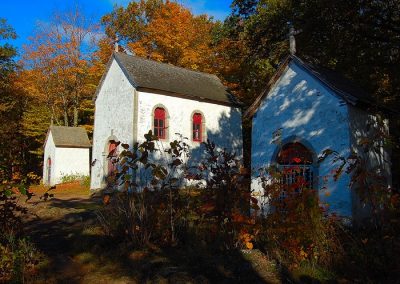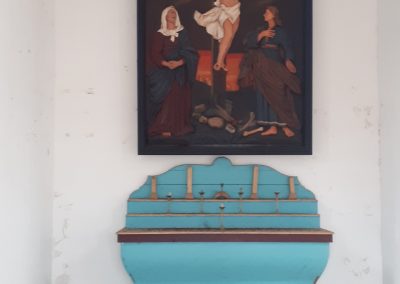Calvary of Oka
The origin of the Calvary of Oka:
After the founding of Quebec in 1608, several religious communities moved to New France to spread the word of God to the Natives, and their conversion raised linguistic and cultural problems. These communities employed various techniques of persuasion, including the establishment of missions in Native territory, the translation of religious texts into Native languages, and the development of biblical imagery that was understandable to the Natives and compatible with their culture. In 1717, the seigneury of Lac-des-Deux-Montagnes was granted to the Sulpicians, who moved their mission from Sault-au-Récollet there. They brought together native americans from four nations: Algonquins, Nipissings, Agnies (Iroquois) and Hurons. In 1733, the mission had about 560 resident Natives. The Oka’s Calvary was erected between 1740 and 1742, at the initiative of the Sulpician Hamon Le Guen (1687-1761). It is composed of seven chapels that house works of art representing episodes of the Passion. Contrary to the habit of the missionaries to bring the natives to their chapel, the Sulpicians established this place of worship in the mountain, an environment familiar to the First Nations in order to better evangelize them. This Way of the Cross is one of the most important manifestations of the vast enterprise of evangelization of the Natives and it is the only one of its kind in Quebec.
The Calvary of Oka was also the most important place of pilgrimage in the Montreal region during the nineteenth century. Held in mid-September, the annual feast of the Exaltation of the Holy Cross attracted up to 30,000 people in 1889.
The Seven Paintings of the Calvary:
The story behind the seven carved paintings of the Calvary of Oka is unique. Created around 1775 by François Guernon dit Belleville, they were intended to replace the canvases installed in the seven small chapels along a pilgrimage – and evangelization – trail created by the Sulpicians in what is now Oka National Park in the Laurentians.
Over time, the wooden bas-reliefs, exposed to harsh weather conditions, have been painted and repainted… And not always for the better. In 1970, almost 200 years later, they were removed from the small white chapels after being vandalized. It was only in 2004 that new copies, made by Georges Vincelli, were reinstalled. The originals were almost sold at auction in 2011. The Musée de la civilisation (Museum in Old Quebec) saved them in extremis, through its Foundation, for the sum of $150,000.
Sources:
patrimoine-culturel.gouv.qc.ca/rpcq/detail.do?methode=consulter&id=93537&type=bien



